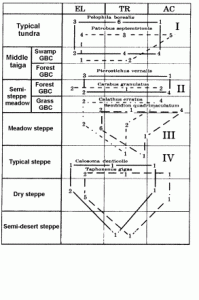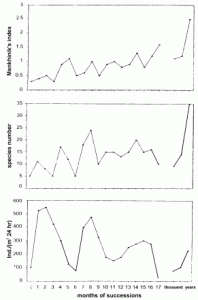Institute for Systematics and Ecology of Animals, SB RAS, Novosibirsk
Head of the Institute:
Vadim I.Evsikov, Corresponding Member of the RAS, Professor
11 Frunze Str., Novosibirsk, 630091, Russia
Tel: +7 (3832) 170-973
Fax: +7 (3832) 170-973
email: zoo@zoo.nsk.su
Principal researchers:
V.G.Mordkovitch, Doctor of Sciences, Professor, Director of the Zoological Museum
V.V.Dubatolov, Ph.D., senior researcher of the Zoological Museum
I.I.Lyubechansky, Ph.D., scientific researcher of the Zoological Museum
R.Y.Dudko, Ph.D., junior researcher of the Zoological Museum
Project objectives
Comparison of standard and specially devised parameters of biodiversity over about 180 invertebrate families in relation to a range of environmental gradients (latitudinal-zonal, altitudinal-zonal and catena gradients), including those related to anthropogenic disturbance (management gradient).
Background and significance of objectives
Collections and relevant information:
- The Zoological Museum houses a unique collection of about 2 million samples and 25.000 identified species from Siberia and neighbouring areas.
- Information on the distribution of more than 11.000 invertebrate species in Western Siberia accumulated in personal and general datasets of the museum staff, including eight PhD theses prepared and defended in the museum by young researchers over the past five years (chiefly unpublished yet).
- Earlier literature accounts on separate invertebrate groups (primarily insects) were published in the museum, for instance, the six-volume edition on the Cerambicidae in Northern Asia (1976-1985) by A. I. Tcherepanov; The gamasid mites of Western Siberia (1968) by M. S. Davydova and V. V. Nikol’sky; etc.
Ground for the aims:
- With the abundance of particular data and a good collection, there is no standard and integrated evaluation of the level, taxonomic or chorological structure of the biodiversity of arthropod communities in the largest Asian region like Western Siberia. The lack of inventories and sometimes exact identification of species prevents the monitoring and maintenance of the ecosystems occurring in areas with intensive land-use impact.
- Western Siberia is characterised by having an ideally flat surface and the unique distinct zonality, with a wide set of environmental, landscape and management variables. Western Siberia is bounded in the south-east by the Altai-Sayany mountains, which show a distinct altitudinal zonality and stand in the “crossroad” of many zoogeographical provinces. Thus, Western Siberia represents a unique natural training ground for revealing regularities in spatial and structural patterns of the biodiversity across the vast (and still undisturbed in many respects) area from north to south.
Research plan: approaches and methods
General approaches to be used:
- A gradient analysis of biodiversity parameters across a set of natural ecological variables like the catena, latitudinal-zonal and altitudinal-zonal rows of landscapes and ecosystems. Special surveys will also be carried out across the management gradient, i.e. analysis of the biodiversity of invertebrate communities (in representative groups like the carabids, tenebrionids and others) over a variety of different management intensities (e.g. Figs. 1-2).
- Main biodiversity parameters to be evaluated are: 1) species richness; 2) the taxonomic pattern, i.e. the composition of taxa; 3) the taxonomic originality, i.e. the proportion of exclusive (indicator) species compared to the whole number of species found; 4) the quantitative coefficient of endemism; 5) the ecological structure of communities (e.g. composition of life forms, patterns of habitat changes, etc.); and others.
- Methods of the multivariate statistics (e.g. Detrended Correspondence Analysis, Principal Component Analysis, etc.) will be used as indirect gradient ordination techniques.
Research programme:
- Mobilisation and critical selection of literature, collection and own data;
- Evaluation of species richness, population and biomass of invertebrate animals of particular taxonomic groups and totally in separate landscapes, latitudinal zones and altitudinal belts.
- Comparison of the main parameters of biodiversity (see 7.1) in the latitudinal-zonal gradient of the environment from the Yamal tundra to Kazakhstan steppes and in the altitudinal-zonal row of the Altai-Sayany mountains using modern statistical techniques.
- Ecological ordination of key taxa being considered worthwhile indicator groups for monitoring the relative quality of ecosystems and their components.
- Evaluation of spatial-time distribution of insects and its changes in response to different types of disturbance and land use (by the example of representative groups like Carabidae, Tenebrionidae, etc.).
- Information on the museum collection (with a detailed catalogue of species) and the bibliography of the museum staff. In case of additional financial support these data will be made downloadable from the Internet site of the Zoological Museum (http://pisum.bionet.nsc.ru/szmn/).
- Time table: 2-3 years.
Expected results
A review of the population and species richness of about 180 invertebrate families, with an integrate evaluation of taxonomic composition, level, zoogeographical and ecological-geographic structure of biodiversity of Western Siberia (in the first steps as separate issues, further as summary monographs). Taxonomic groups (number of families is given in brackets): arachnida: gamasid (12) and oribatid (63) mites; insects: Collembola (17), Hemiptera (21), Diptera (5), Lepidoptera (35), Coleoptera (18), Hymenoptera (3).
Monograph: Mordkovich V.G., Lyubechansky I.I. & Dudko R.Yu. The carabid beetles of Western Siberia: diversity, ecological ordination, communities, indicating potential. (Half ready, 20 quires). Contents: 1) Taxonomic review and analysis; 2) Originality and endemism of the fauna; 3) Regularities in changing of species richness in relation to the environmental gradients; 4) Ecological ordination of species in zonal-catena matrix of the environment; 5) Spatial structure of communities; 6) Temporal (daily, seasonal, annual) dynamics; 7) Indicating potential of species; 8) Indication of soils and soil processes; 9) Indication of a quality of ecosystems following ploughing up; 10) Ditto following the pasture impact; 11) Ditto in the areas of oil and gas production; 12) Indication of restoring ecosystems.
An up-to-date synopsis dealing with the biodiversity, population, biomass and structure of soil invertebrate communities in Western Siberia in comparison with those in neighbouring regions (Central and Eastern Siberia, The Russian Far East and the Eastern Europe) and in relation to the coordinate grid at about 30° intervals along the longitude axis. Volume: 2-2.5 quires.
List of publications of participants related to the project
150 papers and books connected with the present project have so far been published; selected bibliography is given below.
-
Mordkovich V.G. Peculiarities of the soil zoobiome in Siberia // Soil Sciences. – 1985. – ą 7. – P. 840-849 (in Russian).
-
Mordkovich V.G., Lyubechansky I.I. Zonal-catena order in the ecological ordination of the carabid communities (Coleoptera, Carabidae) in Western Siberia // Progr. in Modern Biology. – 1998. – ą 2. – P. 205-215 (in Russian).
-
Lyubechansky I.I., Mordkovich V.G. A classification of ecological groups of ground dwelling animals by the example of the carabid beetles in Western Siberia // Siberian Biology. – 1997. – ą 6. – P. 597-608 (in Russian).
-
Dubatolov V.V. A list of Arctiinae of the territory of the former USSR (Lepidoptera, Arctiinae). Three contribution to the knowledge of palearctic Arctiinae // Neue Entomologische Nachrichten. – 1996. – Bd. 37. – S. 39-87.
Fig. 1. Patterns of habitat change in the carabid beetles in zonal-catena gradient.
Fig. 2. Changes of carabid community parameters across the succession on disposal areas of KATEK.


